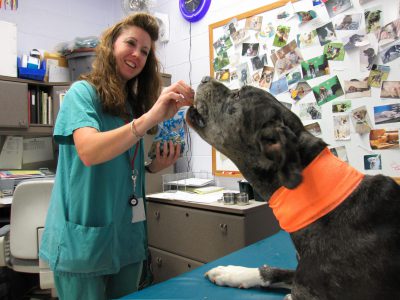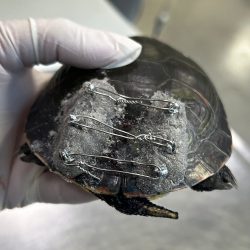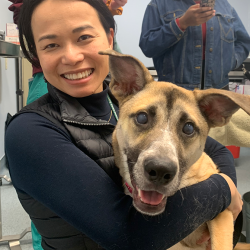
The Emergency Service at the MSU Veterinary Medical Center performs lifesaving procedures every day, but not without help from some four-legged Spartans. They are the Small Animal Clinic's blood donor team—cats and dogs who provide blood and plasma to critically ill or injured animals.
“Our team of canine and feline blood donors is invaluable,” said Rose Wahl, LVT, head of the Hospital’s blood donor program. “Because of their donations, many of our emergency patients are able to make full recoveries and return home healthy.”
Emergency patients are not the only ones who benefit from blood donations. Pets with scheduled surgeries sometimes need blood and plasma, and pets with certain diseases or conditions may need blood or plasma as part of their treatments.
Donation Process
- A small area of fur is clipped and cleaned over the vein in the neck (jugular).
- A needle is inserted into the vein. Blood is collected into a bag where it is weighed to determine the correct amount needed. Cats are sedated during this process.
- After collection, a bandage is placed around the donor’s neck.
- The donor is rewarded with treats, playtime, and praise.
“Our donors give the gift of life to so many patients,” said Wahl. “They exemplify what it means to be a true Spartan.”
The units of donated blood are separated into packed red blood cells and plasma. Each year, the Small Animal Clinic uses approximately 300 units of canine packed red blood cells, 60 units of canine plasma, 60 units of feline packed red blood cells, and 10 units of feline plasma.
One donation helps save up to four lives. On average, donors give six times a year, so the Hospital is able to save up to 24 lives per donor. For their generous contributions, donors receive complimentary annual bloodwork, an annual physical exam, and can choose between a $40 credit with the Hospital or a 40 lb. bag of dog food per donation.
Wahl works closely with every Hospital blood donor. “It’s a great thing to witness,” said Wahl. “The cats and dogs that come in are happy to be here and leave with a job well done and a belly full of treats.”
To learn more about your cat or dog becoming a blood donor, contact Rose Wahl.



